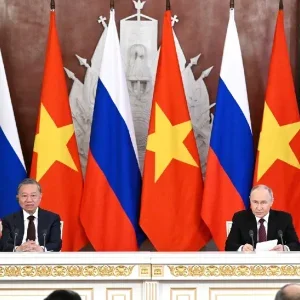54 of 69 samples collected during the 2008/2009 programs have assayed above 0.10% U3O8 with the best sample returning a value of 1.48% U3O8.
During the field program, four new bedrock mineralized zones were located within the gridded portion of a 12 kilometer long favourable structural corridor cutting through the company’s claims.
An aggressive program of grid establishment, soil geochemistry, geological mapping, prospecting and ground geophysical surveying was carried out during the summer of 2009 along a 3.5 km portion of a larger mineralized trend and associated structural corridor discovered during 2008.
The Boiteau Lake Uranium Trend occurs along a well defined, major northeast trending structural feature as defined by airborne magnetic (TMI) data, landsat imagery, airphoto lineations and ground investigation. The trend represents an entirely new discovery of uranium mineralization within the Central Mineral Belt that has never been drill tested. Uranium is generally related to zones of intense fracturing, alteration and carbonate veining within rocks of the mid-paleoproterozoic Joe’s Pond Formation. The Joe’s Pond Formation consists of a variety of lithologies including mafic volcanics, sandstones, conglomerates, chert, argillites, schist, gneiss and pegmatites.
The 2009 exploration efforts were concentrated along a 3.5 kilometer portion of a much larger 12 kilometer structure that passes through the center of the Bayswater Uranium claims. The results of detailed ground work over this portion of the structure were successful in outlining two significant zones of mineralization. Other lower priority zones were also identified. The uranium mineralization noted in both zones is interpreted to be related to a structural contact that may represent a fault zone. The contact zone is well defined geophysically by a linear magnetic low flanking a magnetic high and also by a zone of low resistivity with an associated high chargeability anomaly that likely reflects sulphide content in the uranium mineralized host unit. Fine grained mafic volcanics and argillites hosting the mineralization are highly fractured, altered, carbonitized and contain minor amounts of sulphides.
Central Zone – Rocks of the Central Zone are relatively poorly exposed and stripping was required for the purpose of sampling the main uranium occurrence. The main zone has currently been traced over a 100 meter strike length with widths ranging between 2 and 15 meters. Representative sampling during 2008 and 2009 have returned assays from 15 outcrop samples ranging between 0.11% U3O8 to 0.73% U3O8 , with an average grade of 0.36% U3O8. A ground uranium geochemical soil anomaly, in part coincident with the main mineralized zone, has been delineated for over 900 meters. The soil anomaly is also coincident with an induced polarization/resistivity anomaly and ground magnetic features that provide supporting evidence of a potentially continuous mineralized zone, possibly related to the main bedrock occurrence, all of which are localized along the structural contact zone.
Northern Zone – Additional exploration over a bedrock occurrence located during the 2008 field season has led to the discovery of three additional showings along the same trend. Outcrop exposure in this area is again limited by bogs, ponds and vegetation. The Northern Zone is currently defined over a one kilometer strike length by a series of bedrock uranium showings with coincident, induced polarization/resistivity, soil geochemical and magnetic anomalies with similar characteristics to the Central Zone. A total of 10 samples, including two one meter channel samples, have been collected from this zone. Seven of the ten samples collected returned assays greater than 0.10% U3O8 with the best result grading 0.374% U3O8 . Assays from the 2 one meter channel samples (50236 and 50237) returned values of 0.254% U3O8 and 0.197% U3O8 respectively. Two boulders of very similar lithology were sampled a short distance to the east and returned values up to 1.48% U3O8.
Uranium mineralization along the Boiteau Lake Trend has now been identified for nearly five kilometers. Additional bedrock uranium mineralization has been identified 1.2 kilometers to the north of the Northern Zone and one kilometer to the south of the Central Zone but only limited work has been performed outside the gridded area to date. Mineralization noted in all occurrences is indicated to be related to the same regional structural feature. Bayswater Uranium is currently evaluating its plans for Boiteau Lake for the 2010 field season.






